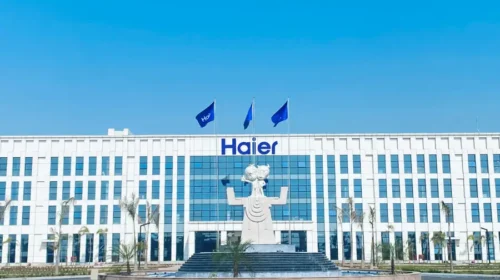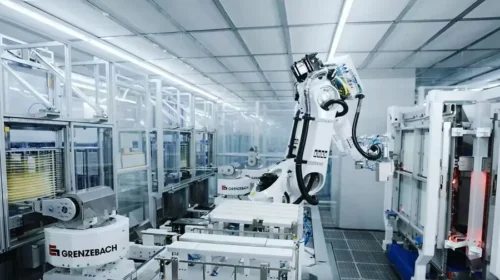EV Slowdown De-Juices Ganfeng Lithium’s Profit Potential

The producer of the key metal used in electric vehicles said its net profit nearly tripled in 2022, even as its two major profit drivers look unlikely to keep up their growth momentum this year
Key Takeaways:
- Ganfeng Lithium said its net profit reached between 18 billion yuan and 22 billion yuan last year, leaping 244% to 321% from 2021
- Recent electric vehicle price cuts after China curbed its prolonged subsidy policies may pressure lithium-related companies in the EV supply chain
By Ken Lo
Oil is often called “black gold,” and the same can be said these last two years for lithium, whose prices have soared on the back of booming demand for the electric vehicles (EV) whose batteries rely on the metal. That fueled a huge surge in profits for lithium carbonate producers like Ganfeng Lithium Group Co. Ltd. (1772.HK; 002460.SZ) last year, even as signs emerge that the boom of 2022 could become this year’s bust.
In a positive profit alert released last week, Ganfeng said it was expecting to report its profit last year ranged from 18 billion yuan($2.65 billion) to 22 billion yuan, up as much as 321% from its 5.23 billion yuan profit in 2021. It added that excluding non-recurring times, last year’s profit would be 17.4 billion yuan to 21.4 billion yuan, up by as much as 636%.
The profit boom came on the back of two main factors that are closely related. One of those was booming demand for Ganfeng’s lithium carbonate that allowed it to sharply boost its prices for that core product. As demand for lithium-based batteries boomed, the company’s lithium battery segment also thrived on demand from not only EV makers, but also solar and wind farm operators who used such batteries to store their excess energy.
Last year marked the latest peak for a Chinese lithium market that has been on a roller coaster ride. After ebbing for years, the futures price of lithium carbonate finally caught fire in 2021, rising from 100,000 yuan per ton in August 2021 to a record 600,000 yuan last November.
What goes up, must come down
But demand has started to decline, taking lithium prices down with it since last year’s peak. And with domestic production still growing strongly, up 89% year-on-year in December alone, the price last month fell about 20% from its high point.
Adding to the woes, China – the world’s biggest lithium consumer – ended 13 years of strong subsidies designed to spur the rapid development of its electric vehicle (EV) industry at the end of last year. The resulting slowdown in the EV market is also likely to pressure lithium carbonate prices.
Ganfeng previously said its net profit, excluding non-recurring items, in the first three quarters of last year rose 872%. That means the full-year forecast for a maximum 636% profit growth on the same basis shows the company’s profit growth slowed sharply in the fourth quarter. In addition to taking a hit from falling lithium carbonate prices, weakening demand for its lithium battery products was also to blame as consumption in China stumbled amid strict Covid-control measures in October and November.
Following Ganfeng’s profit alert, Daiwa Securities issued a research report giving the company a “buy” rating and target price of HK$114, even as it remained bearish on lithium carbonate prices this year. Daiwa pointed out that even though Chinese lithium carbonate futures prices are expected to rebound in the first quarter on inventory replenishment by downstream users, it will remain sluggish from the second to the fourth quarters, sagging to 400,000 yuan per ton by the end of the year.
The future of lithium carbonate prices will largely depend on whether EV sales can continue growing strongly in China, the world’s largest EV market, even after the end of local subsidies. To maintain momentum in the market, international EV giant Tesla (TSLA.US) has taken the lead by marking down prices for its Model 3 and Model Y by more than 10% in China, a strategy which many domestic counterparts may soon follow.
Those cuts could put pressure on Ganfeng, which is one of Tesla’s suppliers. In November 2021, Ganfeng agreed to supply battery-grade lithium hydroxide products to Tesla between 2022 and 2024, with quantity and sales amounts to be determined by Tesla. Tesla’s own EV price cuts could allow it to maintain and even increase its China market share, which could translate to more orders for Ganfeng, potentially offsetting some of the adverse effects of the retirement of subsidies.
Moving up the value chain
Ganfeng has actively expanded its presence in the industry chain in recent years, both for its lithium mining and also in more downstream products. In one of two major moves in that direction announced on Jan. 20, it said it would invest 10 billion yuan to construct a power battery project in the Southwestern city of Chongqing, with an annual capacity of 24 GWh. In the other, it said it would invest 5 billion yuan to set up a new lithium battery project with annual capacity of 10 GWh, as well as a new headquarters for its energy storage product business in the city of Dongguan in southern Guangdong province.
The two projects can source materials from Gangfeng’s lithium mining resources, which include acquisitions in countries like Argentina and Mexico.
Its 2022 interim report showed Ganfeng has lithium carbonate production lines with more than 100,000 tons of annual capacity, including a basic lithium plant in central China’s Jiangxi province, which has become the world’s largest base for lithium salt production. The company has completed the front pyrometallurgical process in the facility’s fourth phase, while the back part is still in progress. When the project is complete, it will be able to process 10,000 tons of high-purity lithium carbonate annually.
Another lithium carbonate project with 40,000 tons of annual capacity at the lithium salt lake Cauchari-Olaroz in Argentina is also being developed, and was expected to gradually ramp up output starting from late last year through the first half of 2023. These two projects alone will provide Ganfeng with sufficient lithium carbonate to increase its battery production.
Its growing presence up and down the lithium product supply chain means Ganfeng will need to boost the quantity of its lithium product sales to fully utilize its growing capacity and offset the effects of falling lithium carbonate prices. The company is also trying to shield itself from market volatility by working with a range of partners on its various projects, lowering its own risk from such major new investments and lightening its capital pressure.
In terms of valuation, Ganfeng trades at a forward price-to-earnings (P/E) ratio of 7.9 times, higher than 6.1 times for rival Tianqi Lithium (9696.HK; 002466.SZ). That could owe partly to Ganfeng’s more diverse layout in the upstream and downstream lithium markets, boosting investor confidence in its longer-term prospects.
To subscribe to Bamboo Works weekly free newsletter, click here






